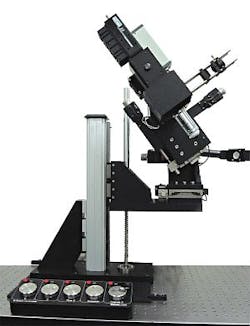Multiphoton imaging system by Thorlabs
The B-Scope multiphoton imaging system from Thorlabs (Newton, NJ) provides over 254 mm of coarse travel in the Z-axis and can rotate, enabling imaging of moving animals. To accommodate experiments requiring a rotation of the imaging plane, the entire optical system pivots around an arc near the focal point of the objective. The system also offers fine control in X, Y, Z, and the rotation T (±25°) through an optically encoded, closed-loop feedback system.
More Biophotonics Products
-----
PRESS RELEASE
B-Scope
The excellent in-vivo imaging capability of multiphoton microscopy has allowed experiments to be carried out in living animals. Often, the experimental apparatus that are coupled to the animal are not compatible with the relatively tight space constraints of most microscopes. In addition, the area of interest may not be accessible when the animal is in its prone position. This situation is further complicated if the animal is awake and moving during the experiment.
Thorlabs’ B-Scope offers a unique solution to the complications mentioned above. Built from the imaging technology developed for our dedicated multiphoton imaging systems, Thorlabs has removed the space constraints imposed by a traditional microscope by providing over 10" (254 mm) of course travel in the Z-axis, giving ample space below the objective. To accommodate experiments requiring a rotation of the imaging plane, the entire optical system pivots around an arc near the focal point of the objective. This is advantageous as tangential planes can be rotated without moving additional axes and ensures Z-focus adjustments are always perpendicular to the imaging plane. The B-Scope also offers fine control in X, Y, Z, (2" in X and Y, 1" in Z) and the rotation T (±25°) through an optically encoded, closed-loop feedback system.
Contact sales at [email protected] to schedule a demo or receive a quotation.
-----
Follow us on Twitter, 'like' us on Facebook, and join our group on LinkedIn
Follow OptoIQ on your iPhone; download the free app here.
Subscribe now to BioOptics World magazine; it's free!
